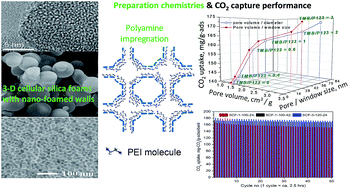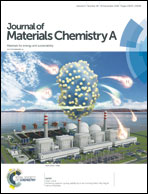Synthesis and functionalisation of spherical meso-, hybrid meso/macro- and macro-porous cellular silica foam materials with regulated pore sizes for CO2 capture†
Abstract
A variety of meso, meso/macro and macro-structured siliceous cellular foam (SCF) materials have been tailor-designed and fabricated using a modified microemulsion templating methodology with trimethyl benzene (TMB) as the pore expander and Pluronic™ block co-polymer (P123) as the surfactant for preparing polyethyleneimine (PEI)-impregnated adsorbents for CO2 capture. The effect of preparation conditions, such as the TMB/P123 mass ratio, aging temperature and aging time, on the SCF morphology and pore structures and hence on the CO2 adsorption performance of the PEI-modified SCF adsorbents was investigated comprehensively. BET measurements and morphological characterisation with SEM revealed that the SCF materials prepared using lower TMB/P123 ratios (≤1) and aging temperatures (≤100 °C) were typically meso-structured with relatively lower cell wall thicknesses but increasing the TMB/P123 ratio, aging temperature and aging times led to a transformation of the SCFs from being meso-structured into hybrid meso/macro or even purely macro-structured nano-cellular materials with increased wall thicknesses, pore volumes and window sizes. CO2 adsorption characterisation of the PEI-impregnated SCFs demonstrated that while all the SCF materials exhibited higher capacities and faster adsorption kinetics compared to conventional meso-structured siliceous materials, the hybrid meso/macro and macro-structured SCF substrates were found to have the best CO2 adsorption performance, with uptake capacities reaching 180.2 mg-CO2 per g-adsorbent (5.85 mmol per g-PEI) for PEI-600 impregnation and 198.2 mg-CO2 per g-adsorbent (6.44 mmol per g-amine) for the hybrid impregnation of PEI-600–TEPA at 75 °C and 0.15 bar CO2, which are significantly higher than those previously reported under similar conditions. The macro- and hybrid meso/macro-structured SCF materials were found to be particularly suitable for preparing high molecular weight PEI-modified adsorbents for greatly improved thermo-stability. At 60 wt% PEI loading, the CO2 capacity reached 126 and 97.3 mg-CO2 per g-ads for PEI-10 000 and PEI-60 000, respectively, both showing extraordinary lifetime performance. Differing from previous findings, no particularly favourable pore diameters or window sizes for PEI impregnation are observed for the wide range of SCF materials examined, although close to linear relationships between the CO2 uptake capacity and total pore volume appear to exist for the SCF materials with pore volumes below 2.2 cm3 g−1 and pore diameters/window sizes ≤ 28 nm.



 Please wait while we load your content...
Please wait while we load your content...